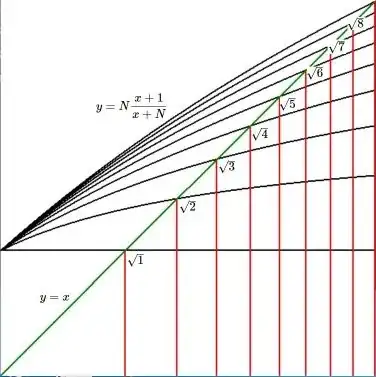The Stern-Brocot tree is one of my favorite tools. It is assumed to be well-known in what follows. Let $m$ and $n$ be positive integers. Initialize (zeroth iteration):
$$
x = \frac{m}{n} < \sqrt{2} \quad ; \quad y = 2/x = \frac{2n}{m} > \frac{2}{\sqrt{2}} \quad \Longrightarrow \quad y > \sqrt{2}
$$
Now walk through the Stern-Brocot tree iteratively until $\,y < \sqrt{2}$ . From the properties of the tree, we know that always will be $\,y > x$ .
First iteration:
$$
y := \frac{m+2n}{n+m} = \frac{x+2}{x+1} < \sqrt{2} \quad \mbox{?}
$$
No, because a contradiction with $\,x<\sqrt{2}\,$ is derived:
$$
(x+2)^2 < 2(x+1)^2 \quad \Longleftrightarrow \quad x^2+4x+4 < 2x^2+4x+2 \quad \Longleftrightarrow \quad x^2 > 2
$$
Second iteration:
$$
y := \frac{m+(m+2n)}{n+(n+m)} = \frac{2m+2n}{m+2n} = \frac{2x+2}{x+2} < \sqrt{2} \quad \mbox{?}
$$
Yes, because:
$$
(2x+2)^2 < 2(x+2)^2 \quad \Longleftrightarrow \quad 4x^2+8x+4 < 2x^2+8x+8 \quad \Longleftrightarrow \quad x^2 < 2
$$
So the outcome is:
$$
y(x) = 2\frac{x+1}{x+2}
$$
Check, check, double check .. If we are allowed to have an embedding of the rationals in the reals, then the derivative is:
$$
y'(x) = \frac{2(x+2)-(2x+2)}{(x+2)^2} = \frac{2}{(x+2)^2} > 0
$$
And some function values are:
$$
y(0) = 1 \quad ; \quad y(\sqrt{2}) = 2\frac{\sqrt{2}+1}{2+\sqrt{2}} = \sqrt{2}
$$
But $y(x)$ is monotonically increasing, so $\sqrt{2}$ is the maximum at the interval $\left[0,\sqrt{2}\right]$ and all other values of $y(x)$ are smaller than this, but greater than $x$, as requested.
BONUS. Let $N$ be any positive integer. Now generalize the question as follows.
Given $x\in \mathbb{Q}^+$ such that $x^2 < N$, how to find $y\in \mathbb{Q}^+$ such that $y>x$ and $y^2 < N$ ?
It's left as an exercise for the reader to prove that this is a solution:
$$
y(x) = N\frac{x+1}{x+N}
$$
Can't resist to display some members of the $y$ - family in a $[0,3]\times[0,3]$ picture:


